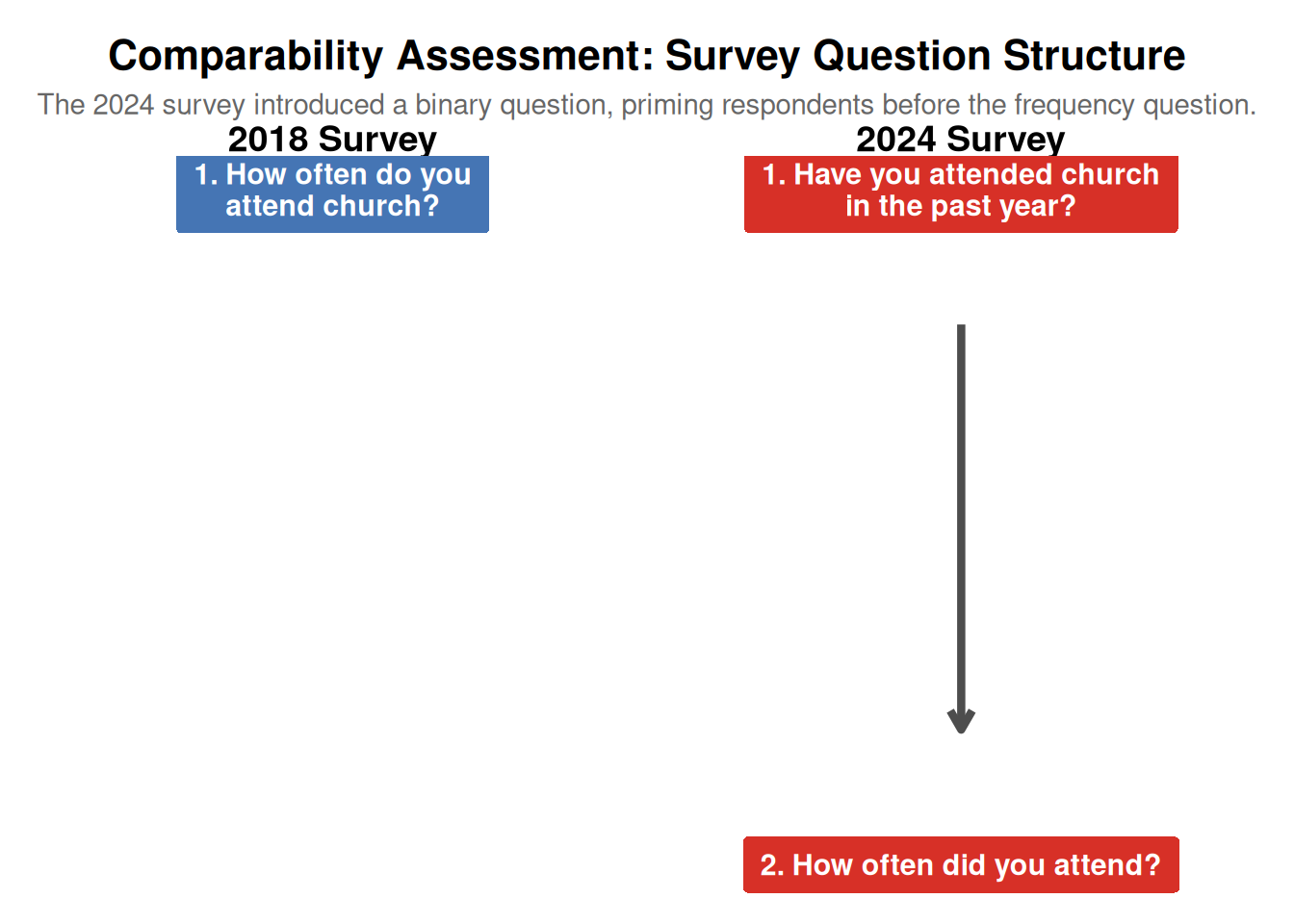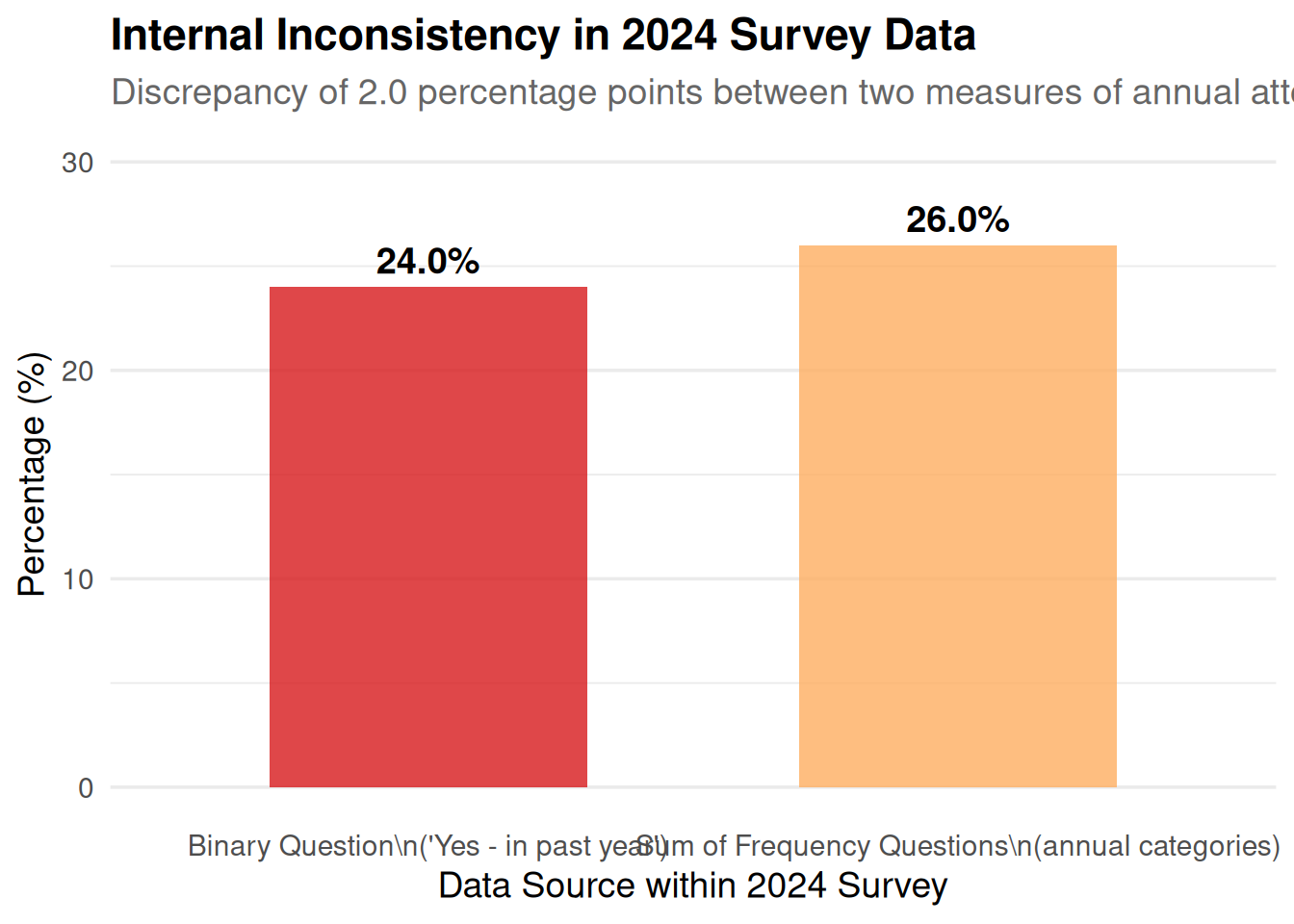
Question Order Effects
Impact of survey design differences on responses
The Problem
The 2018 and 2024 surveys used fundamentally different question formats:
- 2018: Single frequency question only
- 2024: Binary question FIRST (“Yes - in the past year”), THEN frequency question
This violates best practice in survey methodology, as question order can significantly bias responses.
Visualizing the Structural Difference
The most significant methodological flaw is the change in question structure between the two surveys. The 2018 survey asked a single question about frequency, while the 2024 survey first asked a binary yes/no question before asking about frequency. This change introduces a “priming” effect that makes the results from the two years not directly comparable. The chart below illustrates this structural difference.
🚩 CRITICAL: The binary question primes respondents before they consider frequency, which can lead to:
- Acquiescence bias (tendency to say ‘yes’)
- Anchoring effects (binary framing affects frequency judgements)
- Non-comparable measures between years
Internal Consistency Check
If the questions are measuring the same thing, the binary response should match the sum of frequency responses:
Show the code
attendance_data <- read_csv(here::here("data/bible-society-uk-revival/processed/church-attendance-extracted.csv"))
# 2024 binary response
binary_2024 <- attendance_data %>%
filter(year == 2024, question_type == "binary",
response_category == "Yes - in the past year") %>%
pull(total_pct)
# Sum of frequency responses (past year categories)
freq_2024 <- attendance_data %>%
filter(year == 2024, question_type == "frequency") %>%
filter(response_category %in% c(
"Daily/almost daily", "A few times a week",
"About once a week", "About once a fortnight",
"About once a month", "A few times a year",
"About once a year"
))
freq_sum_2024 <- sum(freq_2024$total_pct, na.rm = TRUE)
discrepancy <- abs(freq_sum_2024 - binary_2024)
is_inconsistent <- discrepancy > 2Internal Consistency Check (2024)
If the questions are measuring the same thing, the binary response should match the sum of frequency responses:
- Binary ‘Yes - in the past year’: 24.0%
- Sum of frequency categories: 26.0%
- Discrepancy: 2.0 percentage points
✓ Responses are internally consistent

Evidence from Survey Methodology Literature
Question order effects are well-documented:
- Schuman & Presser (1996): Found order effects of 5-15 percentage points
- Acquiescence bias: Tendency to agree with yes/no questions
- Anchoring effects: First question frames subsequent responses
The 2024 survey design violates the principle that questions should be asked in a way that minimises priming effects when making comparisons over time.
Impact on Weekly Attendance Claim
Show the code
# Weekly attendance in 2024 might be inflated by:
# 1. Acquiescence bias from binary question
# 2. Anchoring effects affecting frequency judgements
weekly_2018 <- attendance_data %>%
filter(year == 2018, response_category == "At least once a week") %>%
pull(total_pct) / 100
weekly_2024 <- attendance_data %>%
filter(
year == 2024,
question_type == "frequency",
response_category %in% c("Daily/almost daily", "A few times a week", "About once a week")
) %>%
summarise(total_pct = sum(total_pct)) %>%
pull(total_pct) / 100Weekly Attendance Comparison
The weekly attendance in 2024 might be inflated by acquiescence bias from the binary question and anchoring effects affecting frequency judgements:
- 2018 (frequency question only): 7.0%
- 2024 (after binary question): 11.0%
- Difference: +4.0 percentage points
⚠️ CAUTION: The apparent increase may be an artefact of question order effects rather than true behavioural change. Without the binary priming question, the 2024 figure might be lower, showing no real change or even a decrease.
The Contradictory Evidence
Interestingly, the binary question itself shows a decrease:
Show the code
# 2018 "ever attended" estimate (sum of all frequency categories except "Never")
ever_2018 <- attendance_data %>%
filter(year == 2018) %>%
filter(response_category != "Never") %>%
summarise(total = sum(total_pct, na.rm = TRUE)) %>%
pull(total)
binary_2024 <- attendance_data %>%
filter(year == 2024, question_type == "binary",
response_category == "Yes - in the past year") %>%
pull(total_pct)‘Ever Attended’ Comparison
Interestingly, the binary question itself shows a decrease:
- 2018 (frequency-based): 52%
- 2024 (binary question): 24.0%
- Change: -28.0 percentage points

🚩 CONTRADICTION:
The binary question shows a DECREASE (27% → 24%), while the frequency question shows an INCREASE (7% → 11%). This contradiction is critical evidence:
These cannot both be true. This is strong evidence that question order effects are creating measurement error.
Conclusion
The different question formats make direct comparison between 2018 and 2024 problematic. The question order effects likely:
- Inflate the weekly attendance figure in 2024 due to acquiescence bias
- Create internal inconsistencies within the 2024 survey
- Produce contradictory results that cannot both be true
Recommendation: The 7% → 11% increase claim should be treated with extreme caution. The methodological differences make the comparison invalid without controlling for question order effects.